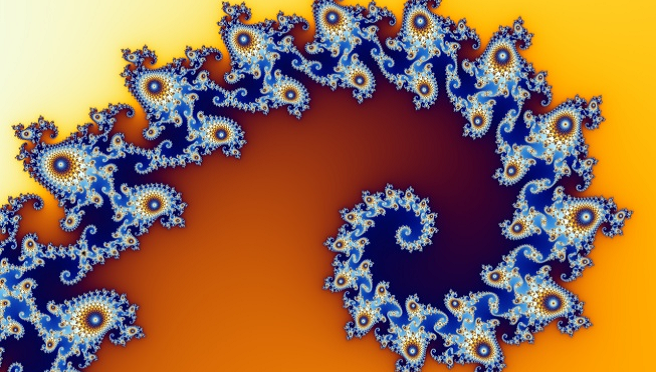By Fedde Benedictus

Buried beneath spirals
Ever since humans began using stone slabs for the decoration and demarcation of their gravesites, masonry has been employed to show the social status of the deceased individual. In this tradition, the Swiss mathematician Jacob Bernoulli chose the figure of a logarithmic spiral to be carved onto his gravestone. The latin motto Eadem mutata resurgo (“Changed and yet the same, I rise again”) was to surround the spiral. However, when he died in 1705, the stonemasons that were responsible for the beautification of Bernoulli’s grave carved an Archimedean instead of a logarithmic spiral into it (see figure 2). And by doing so, they made a crucial mistake.

Bernoulli chose the logarithmic spiral, in combination with the motto, for a reason. For him, the words “Changed and yet the same, I rise again” convey the same meaning as does the figure of the spiral. But why is that? And what does the specific type of spiral matter?
Spiral Types
To answer these questions, we must first understand the difference between the two types of spirals. For that, I will start with a description of the Archimedean spiral. This spiral can be thought of as describing the trajectory of a moving object that undergoes two types of motion at the same time: a linear motion at constant speed (radially outward from the center of its frame of reference) and a constant circular motion. The resulting trajectory is a spiral whose windings remain at an equal distance from each other (because the radial speed is constant). Such a spiral is shown in figure 3.
Figure 3: An Archimedean spiral.
A logarithmic spiral, on the other hand, results if the outward motion along the radius is not constant, but increases as the distance from the spiral’s center becomes larger. The result, as can be seen in figure 4, is a spiral whose subsequent windings become increasingly wide-spaced.

Fractals
By comparing figures 3 and 4 we clearly see the difference between the two types of spirals. The Archimedean spiral paces outward from its center at a steady rate. The logarithmic spiral, on the other hand, gains more and more speed as it moves away from its center. The latter pattern—of the logarithmic type—is very much similar to patterns of organic growth. The speed with which an organism grows depends on its size: the bigger it becomes, the faster it grows. Just like the logarithmic spiral. Because of this characteristic, we find logarithmic patterns everywhere in nature. See for example the figure of the Nautilus shell at the top of this article. A remarkable result of the difference in the spacing of the spiral windings is nicely illustrated by the set of mathematical functions called fractals (see figure 5 for an example of a fractal). The logarithmic spiral is a specific form of a fractal. Fractals have the amazing property that they look the same at different scales: you can zoom in on or out of a picture of a fractal any number of times and you will still see the same structure, a fractal structure.

Ok, so there’s a difference between logarithmic and Archimedean spirals—one looks the same at different scales, and the other does not. But what does that have to do with the motto on Bernoulli’s gravestone?
Some spiral!
Let’s take another look at fractals. We remember that they look the same even if we change the scale at which we look at them. Changed and yet the same—reminds you of something? Of course it does. It has the same sound as does Bernoulli’s motto:
“Changed and yet the same, I rise again”
What did Bernoulli himself write about these things? The beauty of the logarithmic spiral made such an impression on him that he called it the spira mirabilis (miraculous spiral). In an article Bernoulli wrote in 1692 about spirals and other cycloids he says:
“Because our miraculous curve always in its changes remains constantly the same and identical in type, it can be regarded as the symbol of fortitude and constancy in adversity: or even of the resurrection of our flesh after various changes and at length after death itself.”[1]
The resurrection theme from the motto, we now see, has everything to do with spirals. Only the spirals in question are of a very specific kind. However, because the masons responsible for Bernoulli’s tombstone used an archimedean instead of a logarithmic spiral, the spiral was entirely beside the mark! For Bernoulli, the archimedean spiral was merely a mathematical curiosity. The logarithmic spiral, however, he held to be symbolic for a potentially endless cycle of lives. Bernoulli wanted a logarithmic spiral on his gravestone because for him it signified life after death.
o-o-o
All figures used in this article can be found in the public domain. Fedde Benedictus is doing research in order to obtain a Ph.D. in the philosophy of physics. He stumbled upon Bernoulli’s story when delving into the history of the theory of probability, which is one of the pillars on which his research rests.
[1] Bernoulli, J. (1692). Lineae cycloidales, evolutae, ant-evolutae … Spira mirabilis. English translation in: F. N. David, Games, Gods, and Gambling (New York: Hafner, 1962), pp. 138-139.


